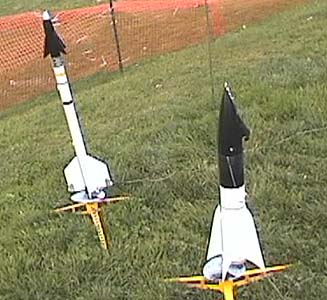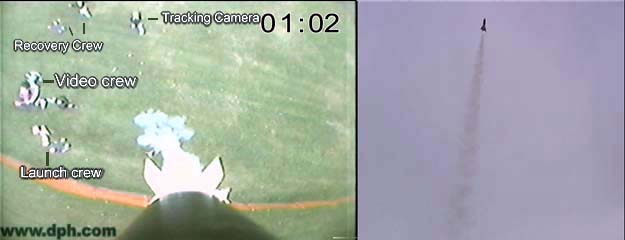
Vidroc Flight #3

Vidroc 1.5 (single stage) on launch pad, with a Sidewinder
Flight Video

Full Speed
Half Speed (field separated / "expanded" video)
Ejection Charge sequence only

Split screen of the Launch with ground tracking
The plan for this launch was to determine if the upper stage by itself had poor flight characteristics and at the same time simultaneously launch another rocket moments after Vidroc takes off, thinking that would make for some cool footage.
Well, the Sidewinder (pictured above) failed to ignite so that "experiment" will have to wait for the next time out. Too bad, because the footage was spectacular.
There were only a few minor video glitches during the flight. Interestingly enough, there was one at the launch pad and another a little later in the flight, but it was clear at deployment of the recovery chutes, and that yielded some wonderful footage.
If you look at the individual frames of the ejection charge, you can see a small puff of smoke at the tail end of the rocket, 1/60th of a second before the camera section starts to separate from the rocket body.
The solid white/beige crumpled mass you see falling back with the rocket body is recovery wadding, a fire proof tissue paper used to protect the parachutes from the ejection charge. I should note here, this is what we would have seen if Flight 1 had blown the ejection charge correctly.
You can also clearly make out a few of the ejection charge "fireballs" that often can damage the plastic parachutes. Those little orange and white bundles with all the strings wrapped around them are the chutes.
Of course I hadn't changed the parachute mount yet, so the recovery spins all the way down. There are some great stills which are a testament to the shutter speed of the X10 camera.
Epilog: The Vidroc upper stage flew pretty much like it did after staging on the previous flight, so I figure the new camera shroud must be influencing the flight direction. Subsequently, I decided to shut down flying for the day so I could revisit the design of the camera and shroud.